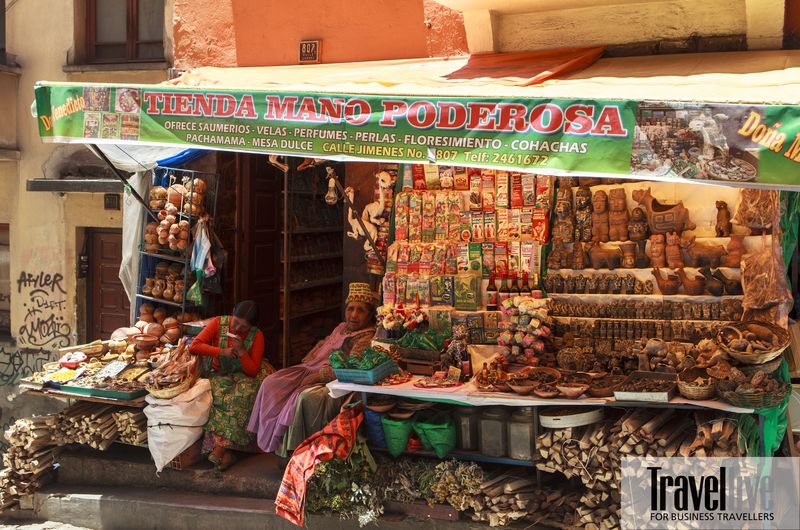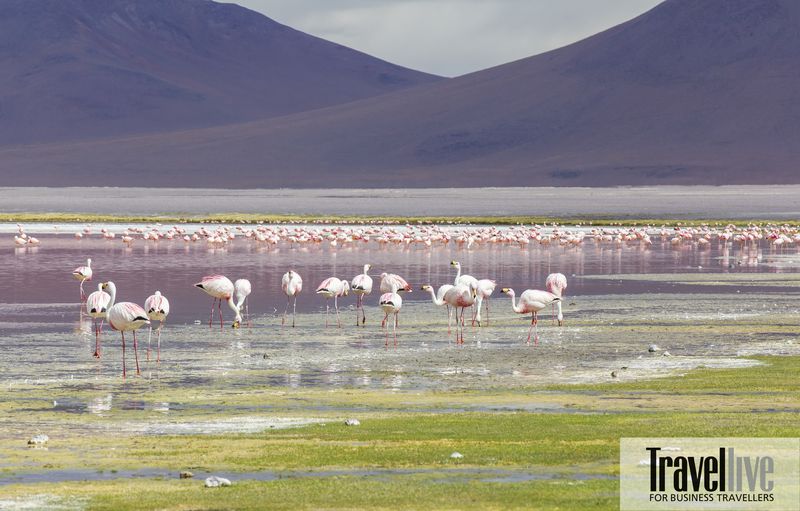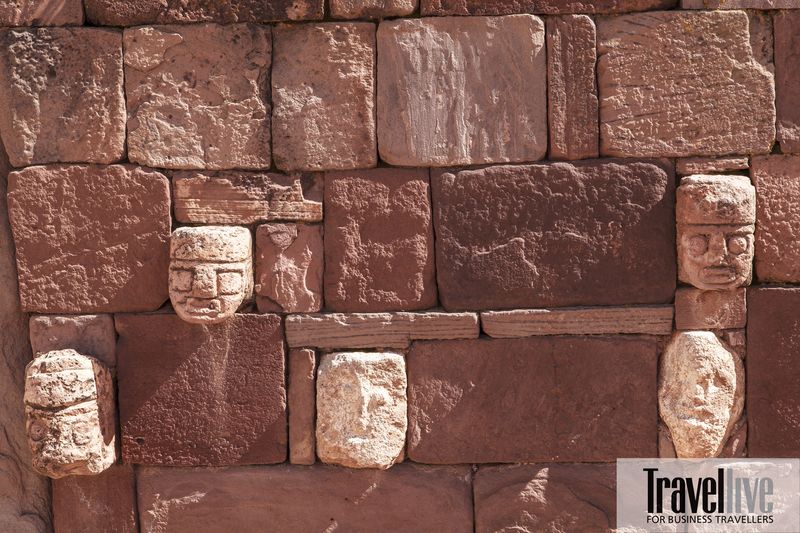While researching information for my South American trip, I suddenly discovered an interesting detail about Bolivia, a country nestled in the mountains of the Andes. Following the information, I was drawn into the endless journey of searching for the giant treasure that humans have been carrying out for more than four centuries. That journey spanned from giant stone plateaus, lakes filled with red sediment to dangerous caves in the Andes that were home to the Inca Indians.
_result.jpg_11.jpg)
Beautiful nature Bolivia.
According to legend, the Inca King Atahualpa was taken prisoner by the Spanish. The leader Pisarro promised to free the king if he could gather enough gold to fill the room in which he was imprisoned within two months. The royal family took the entire treasury and plundered the entire country, finding dozens of cubic meters of gold, along with many gems and jewels, but it was still not enough. The time limit expired, and Pisarro ordered the king's execution. When they heard that the King had died, the gold carriers on the backs of 11,000 Llamas took the gold and hid it somewhere unknown in the Andes.
Sucre, where 5,000 ancient dinosaur footprints were printed

The wall has 5,000 dinosaur footprints printed on it 80 million years ago.
Sucre was the gateway I chose to begin my journey into the mysteries of Bolivia. On the outskirts of Sucre, a 1,200-meter-long, 80-meter-high cliff covered in dinosaur footprints was exposed during the expansion of a local cement factory mine.
During the Cretaceous period, this was a lakeshore area that attracted many herbivorous and carnivorous dinosaurs. Their feet sank into the soft soil in the hot, humid weather. When the area experienced severe droughts, the footprints hardened. Later, the rains buried them under mud and silt.
The local guide explained that this cycle repeated itself up to seven times, preserving many layers of footprints. Subsequent tectonic movements pushed the flat land up, creating the steep cliffs we see today. The Sucre government was struck by a treasure when this unique land was discovered. They began building a museum, life-size models of giant dinosaurs, and an observatory so visitors could see with their own eyes the movements of giant dinosaurs through their footprints. Sucre became the historical land with the most fossilized dinosaur footprints in the world.
The world's most terrifying witch market
Leaving the constitutional capital Sucre, we took the night bus to La Paz. This is the administrative capital of Bolivia, attracting hundreds of thousands of foreign tourists every year because of its many unique "firsts". Located in a valley in the Andes Mountains at 3,640 meters above sea level, La Paz is considered the highest capital in the world and is known as the city hidden in the clouds.

The geographical location of La Paz is very special in terms of altitude, which also reflects the city's society. The rich people settle in the lowest area in the valley. They will choose villas or private townhouses for convenient work and living. The middle class chooses high-end apartment buildings near the city center. The higher up, the brick houses perched on the hillsides are the home of low-income people. Sometimes, they have to wake up very early to move down to the center, to go to the factory to work to avoid the endless traffic jams in the capital during office hours.
We ventured into the witches' market in La Paz to discover the many mysteries of the culture of the Andean people. Over hundreds of years, the unique mystical items in this market have remained virtually unchanged in their spiritual symbolic meaning.

Spiritual symbols of good luck of the people
My friend screamed when she saw the creepy products displayed in the shops. For 5-10 Bolivianos, visitors can buy a dried Llama fetus, a South American llama, which is hung in front of the shops along the market street. According to the brown-faced shopkeeper, the fetus is buried deep under the house by Bolivians as a sacrifice to Mother Earth Pachamama, praying for luck, health and happiness for family members. Dried Aymara frogs bring wealth and prosperity. Small effigies in traditional Bolivian costumes wearing bags of grain are symbolized as the god of wealth, bringing fortune to the family and are also believed to influence the spirits residing in the spiritual world. The items here are not only used as charms or in worship rituals, but they are also used to cure diseases.

When we learned more, we also learned that an unwritten rule when tourists come to the witch market in La Paz is to always show respect for the local cultural beliefs. Because the market is a serious and sacred business with spiritual colors of the indigenous people. They spend time and effort to advise customers to find a suitable amulet or medicine. Any disrespectful or disrespectful actions of tourists will certainly not be welcomed by the people.

The witch market in La Paz is a serious and sacred business with spiritual undertones for the indigenous people.
Strange mirrors of creation
The bus took us out of Uyuni town to the world’s largest salt flats, located at an altitude of nearly 4,000m above sea level. On the way, the bus stopped at the “railway graveyard”, about 3km from the town, where many giant rusted locomotives were gathered.
This was once Bolivia’s largest train station, but is now a huge scrap yard. It was built in the late 19th century by British engineers living in Uyuni. At that time, the leaders believed that they would create a modern transportation system that would help develop the country. The trains were very useful for transporting minerals and goods in and out of the country. However, the indigenous people here saw the trains as a foreign intrusion and often sabotaged them. Later, in the 1940s, when the resources were depleted and the mining industry collapsed, the trains became useless and were left to decay.

We continued on our way and stopped at a village specializing in mining and processing salt from Salar de Uyuni. Here, salt is harvested in the traditional way. First, the salt is piled into small mounds to evaporate all the water, then dried over fire and finally iodine is added before being put into the packaging process. Currently, the people of this area also introduce to visitors the manual salt production process to produce small salt packages for tourists to buy as souvenirs. What is also special is that the houses and hotel system here are built entirely of salt, creating an exciting feeling for tourists, especially couples who need a magical, romantic space.
What's special is that the houses and hotel system in Uyuni are built entirely of salt, creating an exciting feeling for tourists, especially couples who need a magical, romantic space.

Our long awaited destination finally arrived as the sun was high in the sky. The Salar de Uyuni salt flats are located in the southwestern region of Oruno and Potosi in Bolivia near the border with Chile. Over 40,000 years ago, this area was part of the giant prehistoric Lake Minchin. Over time, the lake gradually dried up, revealing two smaller lakes, Poopo and Uru Uru, along with two giant salt deserts, Salar de Coipasa and Salar de Uyuni. Today, Salar de Uyuni is the largest salt desert in the world and 25 times larger than the famous Bonneville Salt Flats in Utah, USA.
The car began to accelerate across the vast salt desert, where I could now only see the sky and the earth meet. During the winter months, this area is completely dry. However, when summer comes, the fields are filled with water, turning the place into a giant magical mirror.
Around the Uyuni salt flats, there are countless lakes where the famous South American flamingos gather to feed and breed. Their food is bacteria and algae in the salt lakes, making Uyuni change color constantly with each season. Every November, thousands of flamingos fly back to enter the mating period, turning the lakes here into splendid mirrors of pink and red.
Surreal Treasures of the Incas
The Tiwanaku ruins are located in the southeast of Lake Titicaca, 72km west of the capital La Paz. Based on the existing traces, archaeologists believe that the area around Tiwanaku was inhabited since 1,500 BC. Most studies agree with the hypothesis that Tiwanaku developed between 300 and 1,000 BC. At that time, Tiwanaku became the political and spiritual center of the entire region.
By 1945, scientist Arthur Posnansky used astronomical techniques and estimated Tiwanaku to be 15,000 years old. However, some people do not believe in the accuracy of this calculation technique. However, most scientists agree that Tiwanaku is the oldest city in the world, even before the legendary Lake Titicaca appeared.
Tiwanaku's dominance began to decline in the 11th century and collapsed completely in the 12th century. However, to this day, scientists have not yet found the answer to why the Tiwanaku empire collapsed, but one thing they believe is that Tiwanaku was once the capital, religious and political center of a powerful empire that lasted 500 years.

Ancient city of Tiwanaku
I was stunned by the archaeological sites that were before my eyes. The most impressive was the massive enclosure surrounding the central temple of Kalasasaya, made of red sandstone weighing up to 130 tons. Scientists are also having a hard time figuring out how the ancients were able to transport the giant stone blocks from a quarry more than 10 kilometers away. Scattered around were structures carved from Andesite bluestone blocks sourced from the Copacabana Peninsula on Lake Titicaca. One theory is that these giant stones weighing more than 40 tons were transported about 90 kilometers across Lake Titicaca by reed boats, then dragged another 10 kilometers to the present-day location of Tiwanaku.

A few hundred meters from Tinawaku is the unique ruins of Puma Punku in the world. Archaeologists believe that Puma Punku was an area of ancient Inca temples and monuments and with what remains today, this place can only be a construction built by aliens! The question is why do they think this is a product not created by humans on Earth? Perhaps the surprising factor of this construction is the giant stone slabs that are intricately carved, perpendicular and have a smooth surface like large, carefully planed wooden planks.
Archaeologists believe that Puma Punku was an area of ancient Inca temples and monuments and with what remains today, this place could only be the work of aliens!
The sites are made of Granite and Diorite, which are second only to diamonds in hardness, making them almost impossible to work with ancient tools. From the looks of it, these slabs of stone could only have been created by machines or even laser cutting equipment. Many of the stones have straight lines, are of absolutely uniform depth and are placed tightly together like a single block of stone. It is unimaginable how such precise work on such a large scale could have been done thousands of years ago.
Puma Punku is located at an altitude of about 4,000 meters above sea level, which means that at this altitude, it is difficult for trees to grow to make wooden rollers when the quarry is hundreds of kilometers away. Thus, moving stone slabs weighing hundreds of tons to this area was unthinkable at that time. Therefore, many people believe in the hypothesis that aliens with advanced techniques created these massive structures or at least they advised the indigenous people to build them. Construction researchers also believe that, in terms of complexity and high technical requirements of the construction, the pyramids in ancient Egypt are too simple compared to the ruins at Puma Punku.

With unsolved mysteries, Tiwanaku and Puma Punku will still attract the curiosity of tourists who want to learn about ancient civilizations in Bolivia and the whole of South America. Who knows, these surreal works are the eternal treasures of the ancient Incas for posterity. Or this is the place where the giant treasure of King Atahualpa was hidden according to legend.
More information
- Visa
Bolivia is one of the countries that offers a tourist visa at the border for Vietnamese people. You will have your photo taken and a visa stamped in your passport upon entry with a fee of 53 USD/person for a single entry visa, valid for 30 days.
You must prepare documents when applying for a visa at the border gate such as tour schedule, round-trip air ticket to Vietnam, hotel reservation in Bolivia, group list with full information on date of birth, gender, passport number, passport expiration date and especially yellow fever vaccination certificate because according to them, Vietnam is on the list of countries that require yellow fever vaccination when entering Bolivia.
- Means of transport
Currently, there are no direct flights from Vietnam to major cities in Bolivia. You must book transit flights in some other cities in South America such as Sao Paulo (Brasil), Bogota (Colonia), Lima (Peru)... To travel within Bolivia, you can use local buses through the website www.ticketsbolivia.com or www.transcopacabanasa.com.bo. Some bus routes have a schedule to travel at night.
- Accommodation
If you want to experience the life of the indigenous people, you can stay in very pretty homestays or guesthouses in ancient cities such as La Laz, Sucre, Copacabana... For Uyuni, you should once experience staying in a hotel built entirely of salt at a cost of about 150-200 USD/night.
- Cuisine
Bolivian cuisine can be summed up in the words “meat” and “potatoes”. The most popular meat is beef, followed by chicken, llama and pork. Fish is popular in some areas around Lake Titicaca. Meanwhile, cuy (South American pig) and conejo (rabbit) are specialties in rural areas. Many visitors to Bolivia hope to taste the famous grilled cuy.
_result.jpg_0.jpg)
Bolivia also has popular street food, especially in bustling tourist cities like La Paz and Copacabana.
Some popular dishes: Anticucho (beef heart grilled on skewers, served with potatoes and spicy peanut sauce), Salchipapa (thinly sliced sausages sautéed with potatoes) or Choripan sandwich served with grilled onions and sauce….
- Weather
Most parts of Bolivia have a dry winter climate and a wet summer climate. Despite its tropical latitude, the cities of La Paz and Potosi are located in the Andes at an average altitude of over 3,500 metres, meaning visitors sometimes need to pack warm clothes in April and May. The summer months in Bolivia are November to March, which are generally warmer and wetter. April to October are the winter months, which are cooler and drier.
- Health
Some regions of Bolivia such as La Paz, Potosi, Oruro and Lake Titicaca are at high altitudes so visitors need to take precautions against the symptoms of altitude sickness "sorojchi". Local pharmacies can provide natural herbal medicines to help tourists deal with the symptoms of "sorojchi".
When visiting the Uyuni salt flats, the sun's UV rays are up to 20 times stronger than at sea level, so you should bring a wide-brimmed hat, sunglasses and sunscreen.
10 experiences in Bolivia for couples
- Capture “magic photo” style photos in the Uyuni salt flats
- Flamingo performance at Red Lake
- Hot mineral bath at night at 4000 meters altitude in Potosi
- Explore the surreal ancient structures of the Incas Tiwanaku and Puma Punku
- Stroll around Copacabana city on the shores of Lake Titicaca
- Historic city of Sucre with its romantic slopes
- The capital of hidden wonders La Paz
- The mysterious Inca islands on Lake Titicaca
- Explore street food and spicy grilled cuy
- Stroll the local livestock markets.
Article and photos: Nguyen Hoang Bao


































